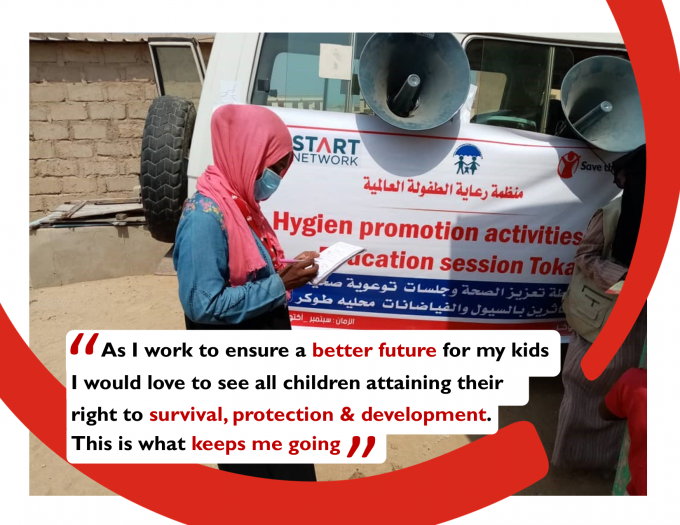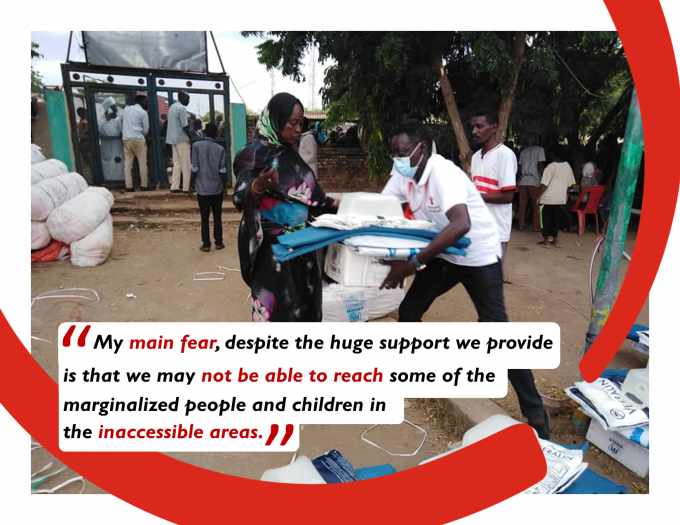Sudan Humanitarian Complex Crisis- Frontline Stories
There is a growing humanitarian complex crisis emerging in Sudan, encompassing conflict displacement, flooding, disease outbreak, and food insecurity.
Despite the Peace Agreement, formally signed on the 3rd of Oct. 2020 in Juba, South Sudan, multiple local conflicts have erupted across the country, in Greater Darfur, South Kordofan, and Eastern Sudan, with increased violence against civilians. Over 125,000 people are displaced by violence since May 2020. Over 875,000 people have been displaced due to floods that started in July 2020. The floods have destroyed homes and infrastructure, including schools and health facilities. In addition to the COVID-19 outbreak, over 10 million people are now at risk of contracting water-borne diseases, and 4.5 million are exposed to vector-borne diseases with current outbreaks of Polio, Malaria, Chikungunya, and VHF.
A 200%+ inflation rates of the Sudanese Pound since 2019 has dramatically reduced household purchasing power resulting in widespread food insecurity and contributing to protests, strikes, and political volatility. As a result, the two Category 3 crisis responses to flooding and conflict amalgamated into one Category 2 (Large) crisis response on October 25th, considering the multiple disease outbreaks, high levels of food insecurity, and hunger, and political instability.
As of 24 November, UNHCR had registered 41,933 new arrivals from Ethiopia. The majority of refugees have arrived at three border points in Kassala and Gedaref states in Eastern Sudan from Tigray. 702 refugees arrived in the Blue Nile. These refugees are Gumuz (not from Tigray area) and fled during clashes with Ethiopian government forces.
Assessments have been conducted and a response plan is being prepared. Save the Children in Sudan is targeting the thematic areas of Protection, including Child Protection, SGBV and FTR; as well as Education; and Health interventions at border and transit areas. Within the Inter-Agency Refugee Emergency Response Plan, Save the Children Sudan has appealed for USD 3,925,000. This will allow Save the Children to target 33% of children with CFS activities, 15% of school-age children with basic education, and 30% of all refugees with basic health interventions. Save the Children has been requested to chair the Education Working Group and the Child Protection sub-sector Working Group for Refugee Response. The Child Protection and Mobile Health response has been initiated from 24 November in Gedaref.
Due to this complex crisis, Save the Children’s offices have expanded to include two additional offices in Sinnar and Al Jazeera states. The number of our staff has increased in response to the outbreak of the Coronavirus. A considerable number of Health Emergency Staff has been recruited in response to the 2020 Sudan flood disaster. Besides mobilizing the efforts and capabilities already in place, Save the Children has deployed a humanitarian emergency team to operate in the most affected states in coordination with the Emergency Health Unit.
“These exceptional times require outstanding nonstop teamwork to reach the most affected and vulnerable population, mainly during this complex crisis of COVID19, flooding, tribal conflicts, disease outbreak, and food insecurity.”- Arshad Malik.
Hear it from our frontline team:

Mariam Abdallah is WaSH officer at Save the Children/ Red Sea field office. As part of the response team, she works on conducting Hygiene promotion awareness activities, and implementing WaSH-related activities for children and communities.
I work very hard and spend extra hours at work to ensure we provide the immediate essential services to the most affected children and families. During these difficult times, I was unable to fulfil my social commitment or spend enough time with my family.
“The bigger the goal, the greater the challenge, says Mariam. We have faced challenges during the lockdown and floods to reach the most-affected people, to the extent that sometimes I have to implement more than one project at the same time. This has a negative impact on the Key Performance Indicators (KPIs), given the fact that we work in distant, hard to reach, and staggered locations, where the tribal conflicts is very active and the political situation is not stable. On top of that, we have to - always consider the dramatic increment of inflation rates.” added Mariam.
Mariam said that her biggest fear is not to reach the most affected needed communities or beneficiaries to deliver aid and assistance at the right time.
"For example, during the protests, we cannot maintain access to reach the affected people. Therefore, we postpone travel until the situation is clear. Also, during the NFI's distribution, we have to ensure the involvements of the local emergency committee, and military members to avoid conflicts between different ethical components of the community" She added.
Despite all those difficulties that she faced during work, Mariam still has the willingness and commitment to continue providing and delivering services and aid to reach the marginalized children in her communities.
“As I work to ensure a better future for my kids, I would love to see all children attaining their right to survival, protection, development, and participation. This is what keeps me going." Adds Mariam.
Save the Children ensures two-way communication through several channels. One of those channels is the complaints number, where our team receives many calls from different areas of our interventions. Through these calls, our beneficiaries express their feelings and needs.
“The needs for each community are various according to their situations. Access to water and energy remains the most needed services for long-term projects. On the other hand, shelter, NFIs, and sanitation are the most required services during emergencies." Mariam says.

Haitham Abu-Elgasim is a WASH technical specialist. He has been deployed to Sennar state- one of the worst affected states during Sudan 2020 floods- working under the capacity of the Emergency Response team to support the setting of Save the Children emergency response to flood-affected people.
“My role was to work with the emergency team to ensure that the most affected people have timely access to appropriate shelters, essential non-food items, water, and health services during the early phase of the emergency to ensure their survival and dignity.” Says Haitham.
Haitham used to work from 7:30 AM up to mid-night during the first phase of the response, in order to ensure that our services reach the beneficiaries in a timely manner. During this time, he couldn’t see or spend time with his family who lives just 5 km distant.
“My main fear, despite the huge support we provide, is that we may not be able to reach some of the marginalized people and children in the inaccessible areas.” He says.
As a Save the Children staff; Haitham has a moral commitment to respond whenever children lives are at great risk, and he can’t just step back when their wellbeing is threatened.
“Our efforts contribute to absorbing the shock among the people who never experienced such emergency. Seeing what we are doing is being appreciated by affected people is what keeps me going and continues” adds Haitham.
Thanks to the generous support of ECHO, USAID's Bureau for Humanitarian Assistance, START Network, and SHF/OCHA, Save the Children in Sudan has reached more than 13,500 households during flood crisis and supporting the isolation center at Khartoum Hospital since last April, in addition to the isolation center at Port Sudan Teaching Hospital in the Red Sea State. Save the Children is also working with the Ministry of Health to equip isolation centers in Kordofan and Darfur states.
Communities still demanding more support to help them overcome this complex crisis. Therefore, Save the Children with the humanitarian partners will keep advocating for more support and resource mobilization to help them settle and keep them protected.
 Sudan
Sudan